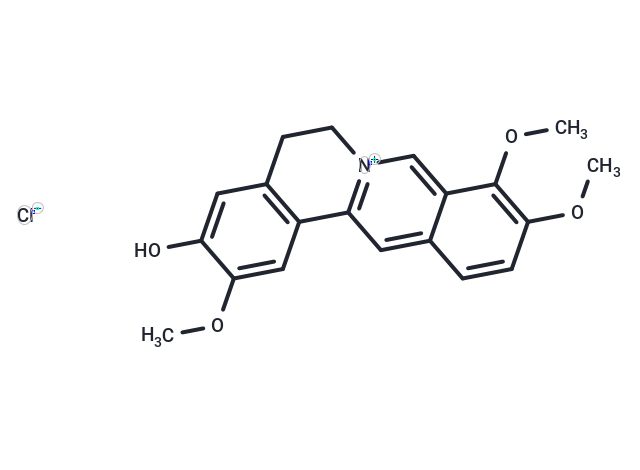Shopping Cart
Remove All Your shopping cart is currently empty
Your shopping cart is currently empty
Jatrorrhizine chloride (Neprotine chloride) is a potent and orally active uptake-2 transporter inhibitor. It exhibits a critical neuroprotective role in H2O2-induced apoptosis via inhibition of the MAPK pathway in HT22 hippocampal neurons.

| Pack Size | Price | USA Warehouse | Global Warehouse | Quantity |
|---|---|---|---|---|
| 5 mg | $31 | In Stock | In Stock | |
| 10 mg | $51 | In Stock | In Stock | |
| 25 mg | $92 | In Stock | In Stock | |
| 50 mg | $157 | In Stock | In Stock | |
| 100 mg | $233 | In Stock | In Stock | |
| 500 mg | $553 | - | In Stock | |
| 1 mL x 10 mM (in DMSO) | $35 | In Stock | In Stock |
| Description | Jatrorrhizine chloride (Neprotine chloride) is a potent and orally active uptake-2 transporter inhibitor. It exhibits a critical neuroprotective role in H2O2-induced apoptosis via inhibition of the MAPK pathway in HT22 hippocampal neurons. |
| Targets&IC50 | AChE:872 nM (IC50) |
| In vitro | Organic cation transporters (OCTs) and the plasma membrane monoamine transporter (PMAT) are major uptake-2 transporters. Jatrorrhizine chloride significantly inhibits the PMAT-mediated MPP+ uptake in a concentration-dependent manner (IC50: 1.05 μM). Jatrorrhizine chloride demonstrates a more powerful inhibition on 5-HT and norepinephrine (NE) uptake mediated by hOCT2 and hOCT3 than that mediated by PMAT. |
| Synonyms | Yatrorhizine chloride, Neprotine chloride |
| Molecular Weight | 373.8 |
| Formula | C20H20ClNO4 |
| Cas No. | 6681-15-8 |
| Smiles | [Cl-].COc1cc-2c(CC[n+]3cc4c(OC)c(OC)ccc4cc-23)cc1O |
| Relative Density. | no data available |
| Color | Orange |
| Appearance | Solid |
| Storage | Powder: -20°C for 3 years | In solvent: -80°C for 1 year | Shipping with blue ice/Shipping at ambient temperature. | |||||||||||||||||||||||||
| Solubility Information | DMSO: 8 mg/mL (21.4 mM), Sonication is recommended. | |||||||||||||||||||||||||
| In Vivo Formulation | 10% DMSO+40% PEG300+5% Tween 80+45% Saline: 1 mg/mL (2.68 mM), Sonication is recommended. Please add the solvents sequentially, clarifying the solution as much as possible before adding the next one. Dissolve by heating and/or sonication if necessary. Working solution is recommended to be prepared and used immediately. The formulation provided above is for reference purposes only. In vivo formulations may vary and should be modified based on specific experimental conditions. | |||||||||||||||||||||||||
Solution Preparation Table | ||||||||||||||||||||||||||
DMSO
| ||||||||||||||||||||||||||
| Size | Quantity | Unit Price | Amount | Operation |
|---|

Copyright © 2015-2025 TargetMol Chemicals Inc. All Rights Reserved.